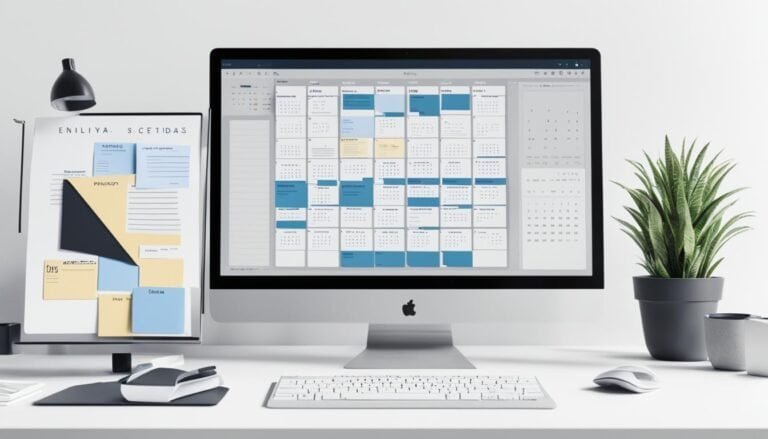Managing Workplace Stress for Better Mental Health
Are you feeling overwhelmed and exhausted by the demands of your job?
Managing workplace stress is crucial for maintaining good mental health, but it's often easier said than done. Finding effective strategies to cope with the pressures of work can significantly improve your overall well-being.
In this discussion, we'll explore practical tips and techniques that can help you navigate workplace stress and create a healthier, more balanced work environment. Whether you're a seasoned professional or just starting out in your career, understanding how to manage workplace stress is essential for your mental health and productivity.
Key Takeaways
- Identifying sources of workplace stress is the first step in effectively managing it.
- Establishing clear boundaries, priorities, and promoting work-life balance are crucial for reducing stress.
- Practicing mindfulness, relaxation techniques, and seeking professional help can alleviate workplace stress.
- Building supportive relationships, team building activities, and a supportive leadership approach contribute to a positive work environment and better mental health.
Understanding Workplace Stress
Understanding workplace stress can significantly impact your overall well-being and productivity. Stress management is essential for maintaining good mental health in the workplace. Identifying the sources of stress, such as heavy workloads, tight deadlines, or conflicts with colleagues, is the first step in managing workplace stress effectively. Once you recognize these stressors, you can take proactive steps to address them. This may involve setting realistic goals, learning to prioritize tasks, or improving communication with your coworkers. Additionally, practicing relaxation techniques, such as deep breathing or mindfulness, can help alleviate the physical and emotional symptoms of stress.
It's important to remember that managing workplace stress isn't solely your responsibility. Employers also play a crucial role in creating a supportive work environment. They can implement policies that promote work-life balance, provide resources for stress management, and encourage open discussions about mental health. By working together, both employees and employers can contribute to a healthier and more productive workplace. Understanding workplace stress and taking proactive steps to manage it's vital for maintaining good mental health and overall well-being.
Identifying Stress Triggers
You need to be able to recognize common stressors that might be affecting you in the workplace.
By understanding your personal triggers, you can take proactive steps to manage and mitigate their impact on your well-being.
It's important to address work-related pressures in a constructive manner to maintain a healthy work environment.
Recognizing Common Stressors
In identifying stress triggers, it's essential to pay close attention to your reactions in various work situations. Recognizing common stressors can help you effectively manage workplace stress for better mental health.
Here are some common stressors to look out for:
- High Workloads: Feeling overwhelmed by an excessive amount of work can be a significant stressor. Keep an eye out for signs of increased irritability, difficulty concentrating, or feeling constantly pressured.
- Poor Work-Life Balance: Struggling to juggle personal and professional responsibilities can lead to significant stress. Look for signs of feeling burnt out, neglecting personal needs, or experiencing strained personal relationships.
- Unclear Expectations: Ambiguity in job roles and responsibilities can cause stress. Pay attention to feelings of confusion, frustration, or anxiety stemming from unclear expectations.
Understanding Personal Triggers
If you find yourself frequently experiencing heightened emotions or physical symptoms in certain work situations, it may be helpful to consider these as potential stress triggers. Identifying personal triggers is essential for managing workplace stress and promoting better mental health. To assist you in this process, consider the following table that outlines common stressors at work and effective ways to manage stressors at home:
| Work Stressors | Managing Stress at Home |
|---|---|
| Heavy Workload | Establishing Boundaries |
| Conflict with Colleagues | Practicing Mindfulness |
| Lack of Control | Engaging in Physical Activity |
| Poor Work-Life Balance | Creating a Relaxing Environment |
| Unclear Expectations | Seeking Social Support |
Understanding your personal stress triggers and implementing strategies to manage them can significantly improve your overall well-being.
Addressing Work-Related Pressures
Identifying stress triggers in the workplace is essential for proactively managing work-related pressures and promoting better mental health. To address work-related pressures effectively, it's crucial to identify the specific stress triggers that may be impacting your mental wellness.
Here's how to do it:
- Keep a stress journal: Record situations that cause stress, your reactions, and how you cope. This can help identify patterns and specific triggers.
- Seek feedback: Ask colleagues or supervisors for input on your work performance and areas where you might be experiencing heightened pressure.
- Reflect on physical and emotional reactions: Pay attention to physical and emotional cues that signal stress. Identifying these reactions can provide insight into the specific stress triggers you need to address.
Establishing Boundaries and Priorities
By clearly defining your boundaries and priorities, you can effectively manage workplace stress and maintain a healthy work-life balance. Establishing boundaries is crucial for protecting your personal time and well-being. It involves setting limits on working hours, responding to emails, and taking on additional tasks outside of your job description.
Prioritizing tasks and managing your time efficiently are essential for reducing stress. Identify the most important tasks and allocate your time and energy accordingly. This will help you focus on what truly matters and avoid feeling overwhelmed by an endless to-do list.
When establishing boundaries, clearly communicate your availability to your colleagues and supervisors. Let them know when you're off the clock and ensure that your personal time is respected. It's also important to prioritize self-care and leisure activities to recharge and prevent burnout.
Practicing Mindfulness and Relaxation Techniques
To further alleviate workplace stress and foster a balanced mindset, engaging in mindfulness and relaxation techniques can greatly enhance your overall well-being and productivity. By incorporating these practices into your daily routine, you can effectively manage stress and improve your mental health.
Here are some techniques to help you achieve this:
- Mindfulness exercises: Practicing mindfulness involves focusing your attention on the present moment. It can be as simple as taking a few minutes to sit quietly and pay attention to your breath, thoughts, and sensations. Deep breathing exercises can also help anchor you in the present and reduce feelings of anxiety.
- Progressive muscle relaxation: This technique involves tensing and then relaxing each muscle group in your body, promoting physical relaxation and reducing muscle tension. Guided imagery, on the other hand, uses visualization to create a mental escape and induce a state of deep relaxation.
- Guided imagery: This technique involves using your imagination to create calming and peaceful images, helping to reduce stress and promote relaxation. It can be particularly effective in creating a sense of calm and well-being during stressful workdays.
Effective Time Management
Consider prioritizing your tasks and setting clear goals to effectively manage your time and minimize workplace stress.
Prioritizing tasks involves identifying the most important and urgent ones, allowing you to focus your energy where it matters most.
Setting clear goals provides direction and helps you stay on track.
One effective time management technique is the Pomodoro Technique, where you work for 25 minutes and then take a 5-minute break. This method can improve productivity and reduce the feeling of being overwhelmed by breaking tasks into manageable intervals.
Building Supportive Relationships
Nurturing positive connections with colleagues and supervisors can significantly contribute to reducing workplace stress and fostering a supportive work environment. Building trust and fostering connections within the workplace is crucial for maintaining a healthy and positive atmosphere. Here are three key ways to build supportive relationships at work:
- Open Communication: Encourage open and honest communication with your colleagues and supervisors. Being transparent about your thoughts and feelings can help build trust and understanding. It also allows for constructive feedback and problem-solving, which can alleviate stress and improve working relationships.
- Active Listening: Actively listen to your colleagues and supervisors. Show genuine interest in their thoughts and concerns. By actively listening, you demonstrate respect and empathy, which are essential for fostering strong connections and a supportive environment.
- Collaboration: Seek opportunities to collaborate with your colleagues. Working together towards common goals can strengthen relationships and create a sense of unity within the team. Collaboration fosters a supportive environment where everyone feels valued and motivated.
Setting Realistic Expectations
Creating realistic expectations for yourself and others is essential for managing workplace stress effectively. Setting boundaries and managing expectations can help alleviate the pressure and anxiety that often accompany unrealistic demands.
Start by clearly defining your roles and responsibilities, as well as the scope of what you can realistically accomplish within a given timeframe. Communicate openly with your colleagues and supervisors about what can be achieved, and be assertive in negotiating deadlines and workloads when necessary.
It's also important to set boundaries to protect your time and mental well-being. Learn to say no when you're already stretched too thin, and prioritize tasks based on their urgency and importance. Avoid taking on more than you can handle, and don't be afraid to delegate when appropriate. By establishing clear boundaries, you can prevent burnout and maintain a healthier work-life balance.
Additionally, managing expectations involves being transparent about what you can deliver. Avoid overpromising and underdelivering, as this can lead to disappointment and increased stress. Be honest about what you can accomplish, and focus on producing quality work within realistic parameters.
Promoting Work-Life Balance
You can promote work-life balance by offering flexible scheduling options, encouraging employees to take time off when needed, and providing remote work opportunities.
These measures can help your team members achieve a healthier balance between their work and personal lives, ultimately reducing stress and improving overall well-being.
Flexible Scheduling Options
To promote work-life balance, consider implementing flexible scheduling options to provide employees with greater control over their work hours. This can help reduce workplace stress and improve mental well-being. Here are three ways flexible scheduling options can benefit your employees:
- Remote Work: Allowing employees to work from home or other remote locations can help reduce commuting stress and give them the flexibility to create a work environment that suits their needs.
- Alternative Hours: Offering varied start and end times can accommodate employees' personal commitments and preferences, enabling them to better balance work and life responsibilities.
- Compressed Workweeks: Allowing employees to work longer hours on fewer days can provide them with additional days off, allowing for more extended periods of rest and relaxation.
Encouraging Time off
Encouraging employees to take time off is another effective way to promote work-life balance and alleviate workplace stress. Providing ample vacation benefits and actively encouraging staff to utilize them can significantly contribute to stress management. Taking time off allows employees to recharge, relax, and spend quality time with their loved ones. It also prevents burnout and boosts overall mental well-being.
As a manager, it's crucial to lead by example by taking your own vacation time and openly supporting your team members in doing the same. Emphasizing the importance of taking breaks and disconnecting from work during vacations can create a healthier work environment and improve employee morale. By prioritizing time off, you not only promote work-life balance but also foster a more productive and resilient team.
Remote Work Opportunities
How can remote work opportunities effectively promote work-life balance for employees?
- Remote collaboration: Working from home allows employees to collaborate with colleagues from different locations, fostering a flexible and inclusive work environment.
- Virtual team building: Virtual team building activities help remote workers feel connected to their colleagues, reducing feelings of isolation and enhancing their sense of belonging to the team.
- Flexibility and autonomy: Remote work provides employees with the flexibility to manage their work schedules, leading to better work-life balance and the ability to attend to personal commitments without compromising productivity.
Seeking Professional Help
If you find that managing workplace stress on your own is becoming overwhelming, consider seeking professional help to develop effective coping strategies. Seeking professional help can provide you with the necessary support and guidance to navigate workplace stress and prioritize your mental health. There are various therapy options and mental health resources available to help you manage workplace stress more effectively. Additionally, seeking professional guidance can also lead to workplace accommodations that can alleviate stress and create a healthier work environment for you.
| Therapy Options | Workplace Accommodations | Mental Health Resources | Professional Guidance |
|---|---|---|---|
| Cognitive Behavioral Therapy (CBT) | Flexible work hours | Employee Assistance Programs (EAP) | Mental health professionals can offer personalized guidance to address your specific workplace stressors and provide coping strategies tailored to your needs. |
| Mindfulness-based Stress Reduction (MBSR) | Remote work opportunities | Supportive online communities | Seeking professional help can also lead to accessing workplace accommodations such as ergonomic equipment or modified work tasks to reduce stress and improve overall well-being. |
| Support Groups | Stress management training | Educational materials | Professional guidance can empower you to advocate for workplace accommodations and navigate any challenges related to workplace stress with confidence and clarity. |
Cultivating a Positive Work Environment
Creating a positive work environment involves:
- Fostering positive team interactions
- Promoting a supportive leadership approach
- Encouraging open communication
By prioritizing these aspects, you can contribute to a workplace culture that values:
- Collaboration
- Empathy
- Constructive feedback
These elements can help reduce stress and contribute to a more fulfilling work experience for everyone.
Positive Team Interactions
Cultivating a positive work environment starts with fostering strong, supportive team interactions that promote collaboration and mutual respect. To achieve this, consider the following:
- Team Building Activities: Engage in team-building exercises to foster camaraderie and trust among team members. This can include group outings, team lunches, or collaborative projects that encourage teamwork and bonding.
- Positive Communication: Encourage open and honest communication to ensure that all team members feel heard and valued. Positive communication can help in resolving conflicts, sharing ideas, and boosting morale.
- Stress Management and Team Dynamics: Implement stress management techniques and strategies to help team members cope with workplace pressures. Additionally, understand and address the unique dynamics within the team to promote a harmonious and supportive work environment.
Supportive Leadership Approach
To cultivate a positive work environment, it is essential for leaders to demonstrate a supportive approach that prioritizes the well-being and growth of their team members. Effective leadership styles play a crucial role in fostering employee support and creating trusting relationships that positively impact team dynamics. By adopting a supportive leadership approach, you can empower your team members to thrive in their roles, leading to increased job satisfaction and productivity. This approach involves actively listening to your employees, providing constructive feedback, and offering resources to help them manage workplace stress. By acknowledging and addressing their concerns, you can build a work environment where team members feel valued and supported, contributing to a more positive and resilient team dynamic.
| Leadership Styles | Employee Support |
|---|---|
| Transformational | Training Programs |
| Servant | Flexible Policies |
| Collaborative | Mental Health Resources |
Encouraging Open Communication
Fostering open communication among your team members is essential for cultivating a positive work environment. By promoting transparency, you create an atmosphere where everyone feels informed and involved, leading to a stronger sense of trust within the team.
Encouraging open dialogue allows for the expression of ideas and concerns, fostering a collaborative and supportive work environment. It's important to provide avenues for feedback, whether through regular team meetings, suggestion boxes, or open-door policies, so that everyone feels their voice is valued and heard.
This not only enhances communication but also empowers individuals to contribute to the overall success of the team. In doing so, you build a foundation of trust and mutual respect, leading to a healthier and more productive work environment.
Conclusion
You've got this! By taking proactive steps to manage workplace stress, you're not only improving your mental health, but also setting yourself up for success.
Remember, it's okay to ask for help and prioritize self-care. You deserve to work in a supportive and positive environment, and by taking control of your stress, you're one step closer to achieving that.
Keep pushing forward and taking care of yourself – you're worth it.







